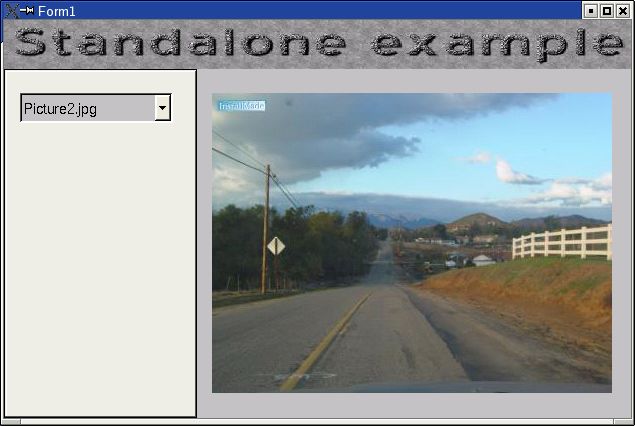{----------------------------------------------------------------------
InstallMade's
Standalone Executable - How-To example
- 03/04/2003 This example demonstrates how to utilize InstallMade's capabilities of reducing the total size of deployed executable by referencing to dynamically loaded data source; double-compressed and stored in the body of the Standalone Executable.
This example uses a directory "DataPicture" with four jpg files and one index file. However, in a real life application the directory can contain many different files and or multiple directories with different content. This whole directory will be compressed along with all the files in it, during the creation of InstallMade's Compressed Standalone Executable and place in the body of the executable.
During the execution of the application the content of this directory will be decompressed into a spawned spool area and can be readily accessed by the application in a similar manner as any other file on the system.
This approach can reduce substantially the overall size of the executable, as much as 10 times of the actual size of the content, if loaded into the application Form during designed-time and deployed traditionally.
Additionally, the standalone executable provides the protection for the content (read-only) and the convenience of one file deployment.
Copyright SuperObject Software Solutions. All Rights Reserved. support@superobject.com
---------------------------------------------------------------------}
unit Unit1;
interface
uses
SysUtils, QGraphics, QControls, QForms,
QStdCtrls, Classes, QExtCtrls, Libc;
{-------------------------------------------------------------------
The application will use libc
function getenv() so we add the
Libc to the uses..
-------------------------------------------------------------------
}
type
TForm1 = class(TForm)
Image1: TImage;
Image2: TImage;
Panel1: TPanel;
ComboBox1: TComboBox;
procedure FormCreate(Sender: TObject);
procedure ComboBox1Change(Sender: TObject);
private
{ Private declarations }
public
spPath, h : string;
{---------------------------------------------------------------
The "spPath" variable will hold the
standalone's spool path
the "h" variable will hold the
home path
-------------------------------------------------------------- }
end;
var
Form1: TForm1;
implementation
{$R *.xfm}
procedure TForm1.FormCreate(Sender: TObject);
begin
{-----------------------------------------------------------------
Here.. in the FormCreate event, we
get the values for "h" and "spPath".
Since the code should work during designed
time and after
the executable is packaged with InstallMade
to become InsatllMade's
compressed standalone executable we need to
provide mechanism which will
allow this application to work inside the
Kylix IDE and when deployed
------------------------------------------------------------------
}
h := libc.getenv('HOME');
spPath := libc.getenv('SP_CATCH');
{---------------------------------------------------------------------
In this example the Project directory
is /home/<user>/example-standalone
and the graphical elements used in
this application are stored in the
subdirectory
/home/<user>/example-standalone/DataPicture, then to be able
access it in designed-time from this
directory and during run-time from
(unknown in designed-time) a spawned
catch of InsatllMade's standalone
executable, we will use this code to
define the value of "spPath" variable.
-----------------------------------------------------------------------}
if spPath = ''
then
//true if run in the IDE
spPath := h + '/example-standalone';
Image2.Picture.LoadFromFile(
spPath + '/DataPicture/app_baner.jpg');
{----------------------------------------------------------------------
Here. in
this example we use an index file to load the filenames of the
pictures and
stored in the directory where the pictures are
stored.
-----------------------------------------------------------------------
}
ComboBox1.Items.LoadFromFile(spPath +'/DataPicture/PictureIndex.txt');
end;
procedure TForm1.ComboBox1Change(Sender: TObject);
begin
Image1.Picture.LoadFromFile(spPath +'/DataPicture/'+ComboBox1.Text);
end;
end.
